Abstract
Somatic O (formerly heat-stable) and heat-labile (HL) serotyping methods are commonly used to type Campylobacter jejuni and Campylobacter coli isolates. Although both systems are effective, the labor and time required for each have limited their application. These systems can be simplified by reducing the number of antisera used. To find an appropriate panel of antisera, we determined the distribution of common serotypes in the United States among a representative sample of 298 Campylobacter isolates. The strains, obtained between July 1989 and June 1990 from persons with sporadic cases of diarrhea, were collected from 19 randomly chosen counties in all geographic (census) regions of the United States. All strains were serotyped by the O and HL systems. By phenotypic methods, 288 C. jejuni, 9 hippurate-negative C. jejuni/C. coli, and 1 Campylobacter lari were identified. Of 57 O antisera, 24 typed 252 (84.6%) strains. Of the 55 HL antisera, 23 serotyped 253 (84.9%) strains. All strains were typeable in the unabsorbed O antisera. In the absorbed HL antisera, four strains were nontypeable and 14 were rough and untypeable. In each geographic region, 9 or more O and HL serotypes were found. Serotypes O:1, O:4, and O:13,16,43,50 and HL 1 were identified in all regions. The combination of both schemes gave greater discrimination than either system alone, but the maintenance of both requires a large resource investment. A serotyping scheme incorporating the 24 most prevalent O and 23 most prevalent HL serotypes could be useful for outbreak support and for surveillance. In the near future, we anticipate using a molecular subtyping method in combination with limited serotyping to distinguish Campylobacter strains.
Full text
PDF
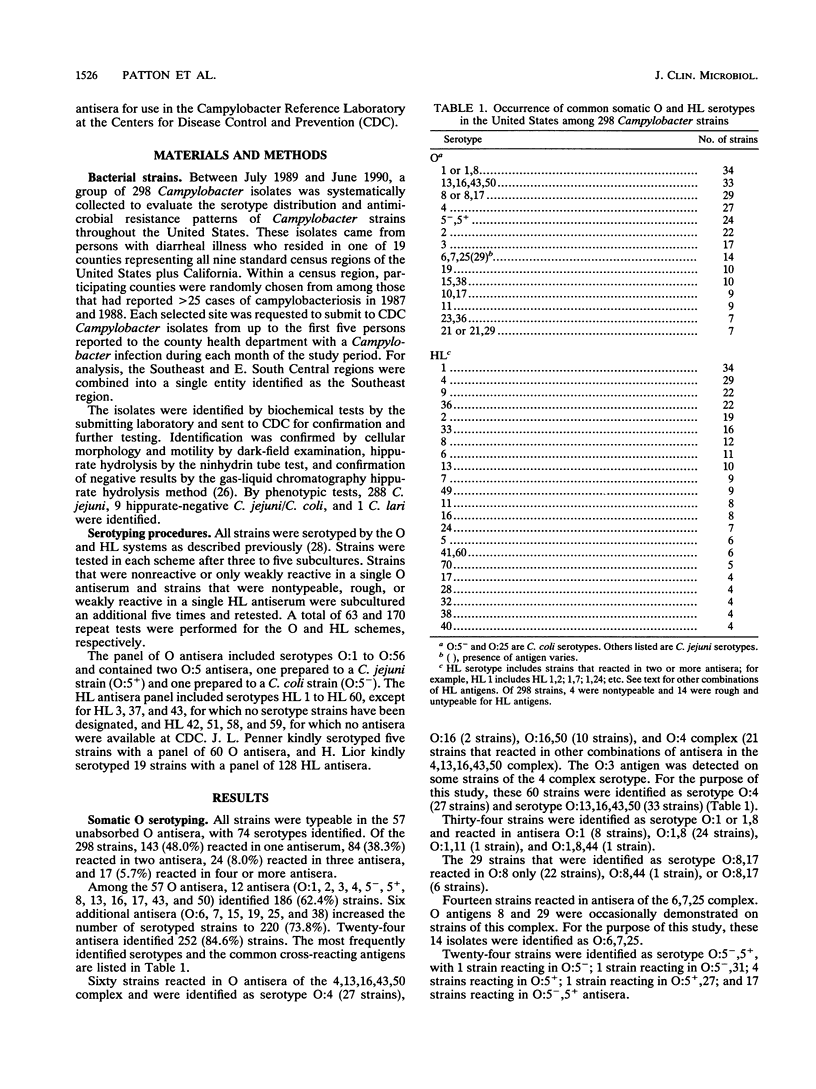
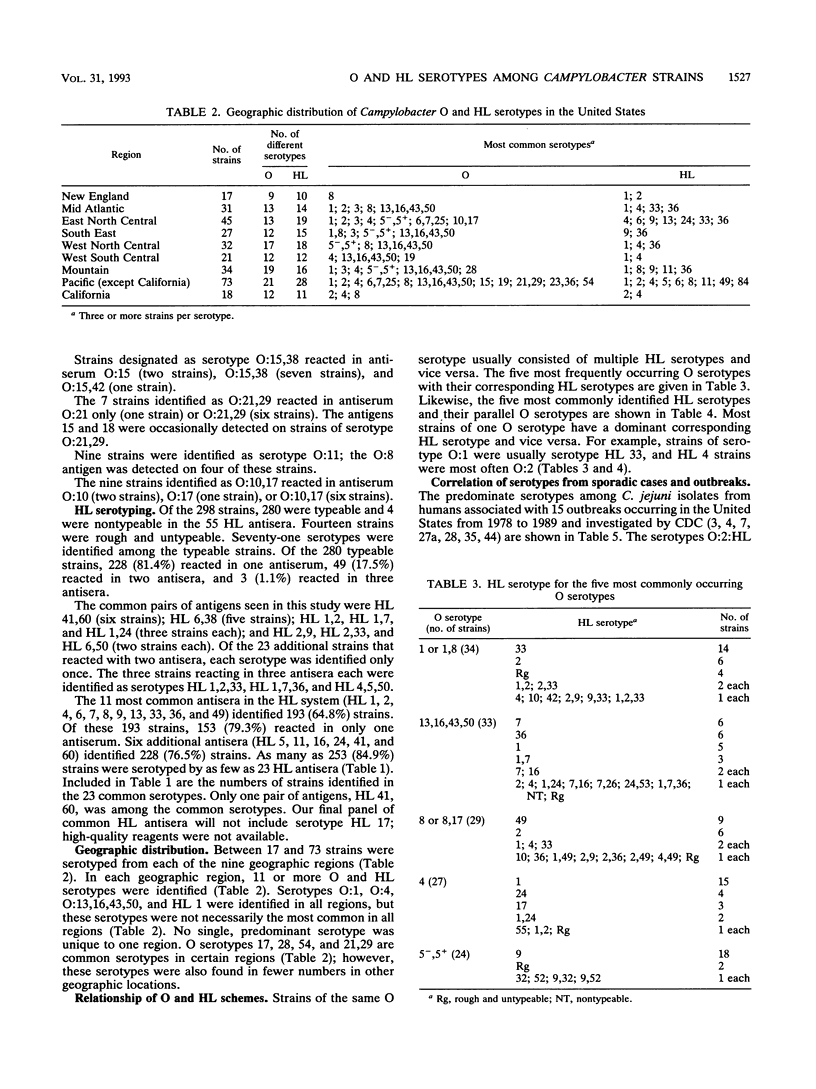
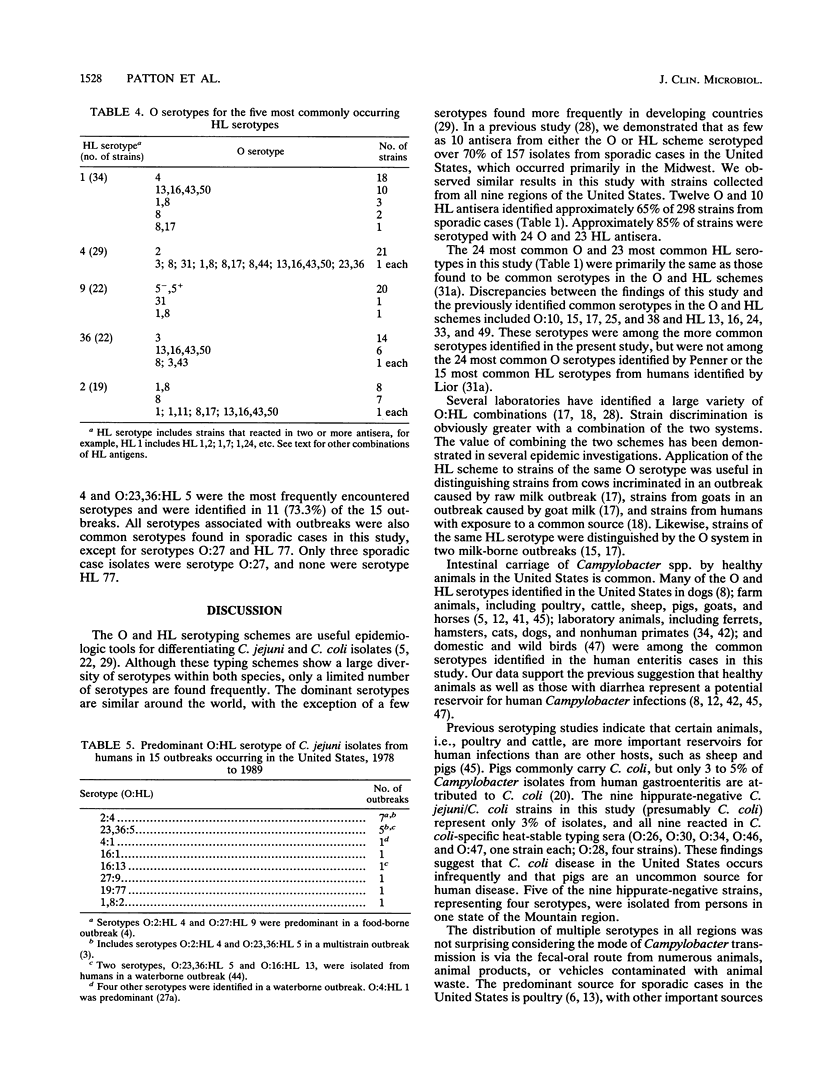
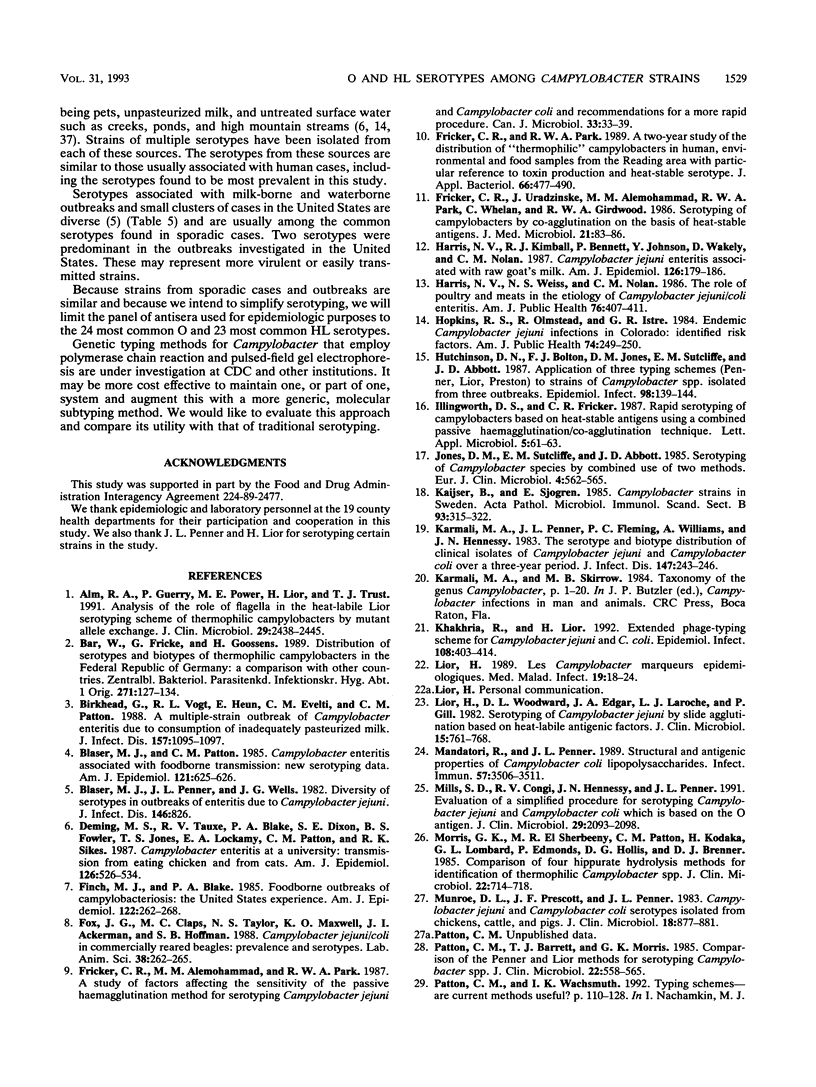
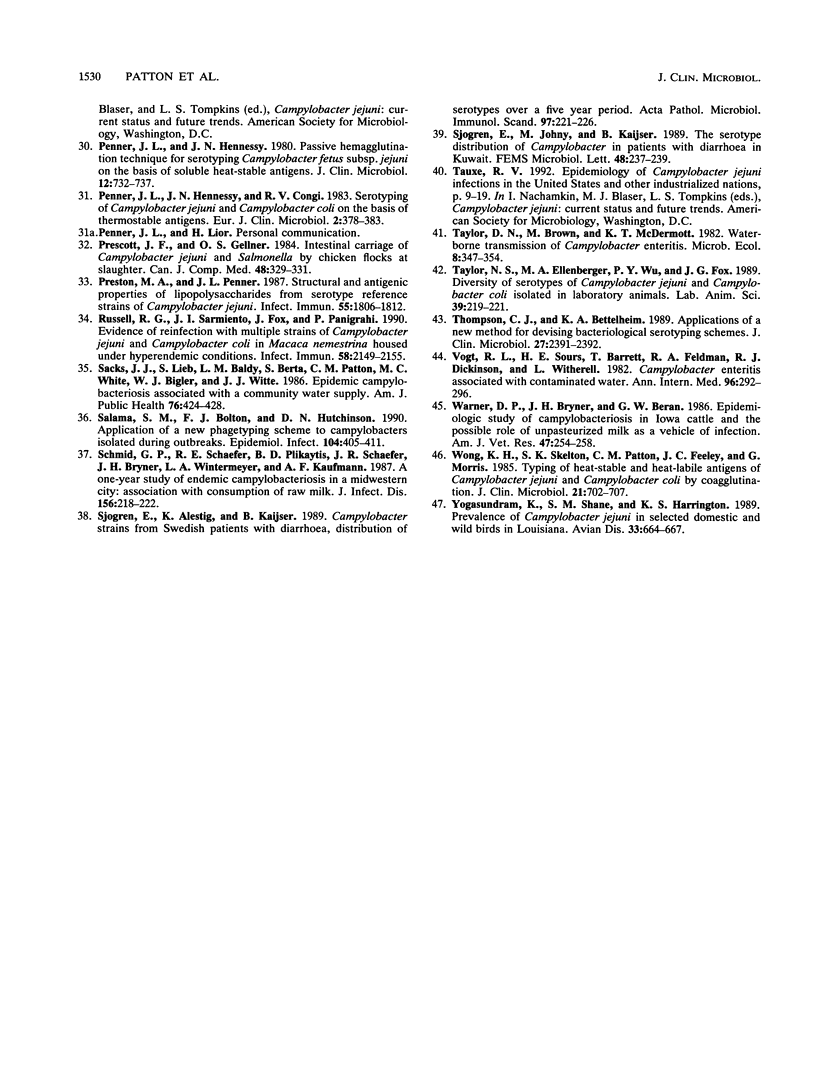
Selected References
These references are in PubMed. This may not be the complete list of references from this article.
- Alm R. A., Guerry P., Power M. E., Lior H., Trust T. J. Analysis of the role of flagella in the heat-labile Lior serotyping scheme of thermophilic Campylobacters by mutant allele exchange. J Clin Microbiol. 1991 Nov;29(11):2438–2445. doi: 10.1128/jcm.29.11.2438-2445.1991. [DOI] [PMC free article] [PubMed] [Google Scholar]
- Birkhead G., Vogt R. L., Heun E., Evelti C. M., Patton C. M. A multiple-strain outbreak of Campylobacter enteritis due to consumption of inadequately pasteurized milk. J Infect Dis. 1988 May;157(5):1095–1097. doi: 10.1093/infdis/157.5.1095. [DOI] [PubMed] [Google Scholar]
- Blaser M. J., Patton C. M. Campylobacter enteritis associated with foodborne transmission: new serotyping data. Am J Epidemiol. 1985 Apr;121(4):625–626. doi: 10.1093/oxfordjournals.aje.a114045. [DOI] [PubMed] [Google Scholar]
- Blaser M. J., Penner J. L., Wells J. G. Diversity of serotypes in outbreaks of enteritis due to Campylobacter jejuni. J Infect Dis. 1982 Dec;146(6):826–826. doi: 10.1093/infdis/146.6.826. [DOI] [PubMed] [Google Scholar]
- Bär W., Fricke G., Goossens H. Distribution of serotypes and biotypes of thermophilic campylobacters in the Federal Republic of Germany: a comparison with other countries. Zentralbl Bakteriol. 1989 May;271(1):127–134. doi: 10.1016/s0934-8840(89)80061-1. [DOI] [PubMed] [Google Scholar]
- Deming M. S., Tauxe R. V., Blake P. A., Dixon S. E., Fowler B. S., Jones T. S., Lockamy E. A., Patton C. M., Sikes R. O. Campylobacter enteritis at a university: transmission from eating chicken and from cats. Am J Epidemiol. 1987 Sep;126(3):526–534. doi: 10.1093/oxfordjournals.aje.a114685. [DOI] [PubMed] [Google Scholar]
- Finch M. J., Blake P. A. Foodborne outbreaks of campylobacteriosis: the United States experience, 1980-1982. Am J Epidemiol. 1985 Aug;122(2):262–268. doi: 10.1093/oxfordjournals.aje.a114097. [DOI] [PubMed] [Google Scholar]
- Fox J. G., Claps M. C., Taylor N. S., Maxwell K. O., Ackerman J. I., Hoffman S. B. Campylobacter jejuni/coli in commercially reared beagles: prevalence and serotypes. Lab Anim Sci. 1988 Jun;38(3):262–265. [PubMed] [Google Scholar]
- Fricker C. R., Alemohammad M. M., Park R. W. A study of factors affecting the sensitivity of the passive haemagglutination method for serotyping Campylobacter jejuni and Campylobacter coli and recommendations for a more rapid procedure. Can J Microbiol. 1987 Jan;33(1):33–39. doi: 10.1139/m87-006. [DOI] [PubMed] [Google Scholar]
- Fricker C. R., Park R. W. A two-year study of the distribution of 'thermophilic' campylobacters in human, environmental and food samples from the Reading area with particular reference to toxin production and heat-stable serotype. J Appl Bacteriol. 1989 Jun;66(6):477–490. doi: 10.1111/j.1365-2672.1989.tb04568.x. [DOI] [PubMed] [Google Scholar]
- Fricker C. R., Uradzinski J., Alemohammad M. M., Park R. W., Whelan C., Girdwood R. W. Serotyping of campylobacters by co-agglutination on the basis of heat-stable antigens. J Med Microbiol. 1986 Feb;21(1):83–86. doi: 10.1099/00222615-21-1-83. [DOI] [PubMed] [Google Scholar]
- Harris N. V., Kimball T. J., Bennett P., Johnson Y., Wakely D., Nolan C. M. Campylobacter jejuni enteritis associated with raw goat's milk. Am J Epidemiol. 1987 Aug;126(2):179–186. doi: 10.1093/aje/126.2.179. [DOI] [PubMed] [Google Scholar]
- Harris N. V., Weiss N. S., Nolan C. M. The role of poultry and meats in the etiology of Campylobacter jejuni/coli enteritis. Am J Public Health. 1986 Apr;76(4):407–411. doi: 10.2105/ajph.76.4.407. [DOI] [PMC free article] [PubMed] [Google Scholar]
- Hopkins R. S., Olmsted R., Istre G. R. Endemic Campylobacter jejuni infection in Colorado: identified risk factors. Am J Public Health. 1984 Mar;74(3):249–250. doi: 10.2105/ajph.74.3.249. [DOI] [PMC free article] [PubMed] [Google Scholar]
- Hutchinson D. N., Bolton F. J., Jones D. M., Sutcliffe E. M., Abbott J. D. Application of three typing schemes (Penner, Lior, Preston) to strains of Campylobacter spp. isolated from three outbreaks. Epidemiol Infect. 1987 Apr;98(2):139–144. doi: 10.1017/s0950268800061847. [DOI] [PMC free article] [PubMed] [Google Scholar]
- Jones D. M., Sutcliffe E. M., Abbott J. D. Serotyping of Campylobacter species by combined use of two methods. Eur J Clin Microbiol. 1985 Dec;4(6):562–565. doi: 10.1007/BF02013395. [DOI] [PubMed] [Google Scholar]
- Kaijser B., Sjögren E. Campylobacter strains in Sweden. Serotyping and correlation to clinical symptoms. Acta Pathol Microbiol Immunol Scand B. 1985 Aug;93(4):315–322. [PubMed] [Google Scholar]
- Karmali M. A., Penner J. L., Fleming P. C., Williams A., Hennessy J. N. The serotype and biotype distribution of clinical isolates of Campylobacter jejuni and Campylobacter coli over a three-year period. J Infect Dis. 1983 Feb;147(2):243–246. doi: 10.1093/infdis/147.2.243. [DOI] [PubMed] [Google Scholar]
- Khakhria R., Lior H. Extended phage-typing scheme for Campylobacter jejuni and Campylobacter coli. Epidemiol Infect. 1992 Jun;108(3):403–414. doi: 10.1017/s0950268800049918. [DOI] [PMC free article] [PubMed] [Google Scholar]
- Lior H., Woodward D. L., Edgar J. A., Laroche L. J., Gill P. Serotyping of Campylobacter jejuni by slide agglutination based on heat-labile antigenic factors. J Clin Microbiol. 1982 May;15(5):761–768. doi: 10.1128/jcm.15.5.761-768.1982. [DOI] [PMC free article] [PubMed] [Google Scholar]
- Mandatori R., Penner J. L. Structural and antigenic properties of Campylobacter coli lipopolysaccharides. Infect Immun. 1989 Nov;57(11):3506–3511. doi: 10.1128/iai.57.11.3506-3511.1989. [DOI] [PMC free article] [PubMed] [Google Scholar]
- Mills S. D., Congi R. V., Hennessy J. N., Penner J. L. Evaluation of a simplified procedure for serotyping Campylobacter jejuni and Campylobacter coli which is based on the O antigen. J Clin Microbiol. 1991 Oct;29(10):2093–2098. doi: 10.1128/jcm.29.10.2093-2098.1991. [DOI] [PMC free article] [PubMed] [Google Scholar]
- Morris G. K., el Sherbeeny M. R., Patton C. M., Kodaka H., Lombard G. L., Edmonds P., Hollis D. G., Brenner D. J. Comparison of four hippurate hydrolysis methods for identification of thermophilic Campylobacter spp. J Clin Microbiol. 1985 Nov;22(5):714–718. doi: 10.1128/jcm.22.5.714-718.1985. [DOI] [PMC free article] [PubMed] [Google Scholar]
- Munroe D. L., Prescott J. F., Penner J. L. Campylobacter jejuni and Campylobacter coli serotypes isolated from chickens, cattle, and pigs. J Clin Microbiol. 1983 Oct;18(4):877–881. doi: 10.1128/jcm.18.4.877-881.1983. [DOI] [PMC free article] [PubMed] [Google Scholar]
- Patton C. M., Barrett T. J., Morris G. K. Comparison of the Penner and Lior methods for serotyping Campylobacter spp. J Clin Microbiol. 1985 Oct;22(4):558–565. doi: 10.1128/jcm.22.4.558-565.1985. [DOI] [PMC free article] [PubMed] [Google Scholar]
- Penner J. L., Hennessy J. N., Congi R. V. Serotyping of Campylobacter jejuni and Campylobacter coli on the basis of thermostable antigens. Eur J Clin Microbiol. 1983 Aug;2(4):378–383. doi: 10.1007/BF02019474. [DOI] [PubMed] [Google Scholar]
- Penner J. L., Hennessy J. N. Passive hemagglutination technique for serotyping Campylobacter fetus subsp. jejuni on the basis of soluble heat-stable antigens. J Clin Microbiol. 1980 Dec;12(6):732–737. doi: 10.1128/jcm.12.6.732-737.1980. [DOI] [PMC free article] [PubMed] [Google Scholar]
- Prescott J. F., Gellner O. S. Intestinal carriage of Campylobacter jejuni and Salmonella by chicken flocks at slaughter. Can J Comp Med. 1984 Jul;48(3):329–331. [PMC free article] [PubMed] [Google Scholar]
- Preston M. A., Penner J. L. Structural and antigenic properties of lipopolysaccharides from serotype reference strains of Campylobacter jejuni. Infect Immun. 1987 Aug;55(8):1806–1812. doi: 10.1128/iai.55.8.1806-1812.1987. [DOI] [PMC free article] [PubMed] [Google Scholar]
- Russell R. G., Sarmiento J. I., Fox J., Panigrahi P. Evidence of reinfection with multiple strains of Campylobacter jejuni and Campylobacter coli in Macaca nemestrina housed under hyperendemic conditions. Infect Immun. 1990 Jul;58(7):2149–2155. doi: 10.1128/iai.58.7.2149-2155.1990. [DOI] [PMC free article] [PubMed] [Google Scholar]
- Sacks J. J., Lieb S., Baldy L. M., Berta S., Patton C. M., White M. C., Bigler W. J., Witte J. J. Epidemic campylobacteriosis associated with a community water supply. Am J Public Health. 1986 Apr;76(4):424–428. doi: 10.2105/ajph.76.4.424. [DOI] [PMC free article] [PubMed] [Google Scholar]
- Salama S. M., Bolton F. J., Hutchinson D. N. Application of a new phagetyping scheme to campylobacters isolated during outbreaks. Epidemiol Infect. 1990 Jun;104(3):405–411. doi: 10.1017/s0950268800047427. [DOI] [PMC free article] [PubMed] [Google Scholar]
- Schmid G. P., Schaefer R. E., Plikaytis B. D., Schaefer J. R., Bryner J. H., Wintermeyer L. A., Kaufmann A. F. A one-year study of endemic campylobacteriosis in a midwestern city: association with consumption of raw milk. J Infect Dis. 1987 Jul;156(1):218–222. doi: 10.1093/infdis/156.1.218. [DOI] [PubMed] [Google Scholar]
- Sjögren E., Alestig K., Kaijser B. Campylobacter strains from Swedish patients with diarrhoea. Distribution of serotypes over a five year period. APMIS. 1989 Mar;97(3):221–226. [PubMed] [Google Scholar]
- Sjögren E., Johny M., Kaijser B. The serotype distribution of Campylobacter in patients with diarrhoea in Kuwait. FEMS Microbiol Lett. 1989 Jan 15;48(2):237–239. doi: 10.1111/j.1574-6968.1989.tb03306.x. [DOI] [PubMed] [Google Scholar]
- Taylor N. S., Ellenberger M. A., Wu P. Y., Fox J. G. Diversity of serotypes of Campylobacter jejuni and Campylobacter coli isolated in laboratory animals. Lab Anim Sci. 1989 May;39(3):219–221. [PubMed] [Google Scholar]
- Thompson C. J., Bettelheim K. A. Applications of a new method for devising bacteriological serotyping schemes. J Clin Microbiol. 1989 Oct;27(10):2391–2392. doi: 10.1128/jcm.27.10.2391-2392.1989. [DOI] [PMC free article] [PubMed] [Google Scholar]
- Vogt R. L., Sours H. E., Barrett T., Feldman R. A., Dickinson R. J., Witherell L. Campylobacter enteritis associated with contaminated water. Ann Intern Med. 1982 Mar;96(3):292–296. doi: 10.7326/0003-4819-96-3-292. [DOI] [PubMed] [Google Scholar]
- Warner D. P., Bryner J. H., Beran G. W. Epidemiologic study of campylobacteriosis in Iowa cattle and the possible role of unpasteurized milk as a vehicle of infection. Am J Vet Res. 1986 Feb;47(2):254–258. [PubMed] [Google Scholar]
- Wong K. H., Skelton S. K., Patton C. M., Feeley J. C., Morris G. Typing of heat-stable and heat-labile antigens of Campylobacter jejuni and Campylobacter coli by coagglutination. J Clin Microbiol. 1985 May;21(5):702–707. doi: 10.1128/jcm.21.5.702-707.1985. [DOI] [PMC free article] [PubMed] [Google Scholar]
- Yogasundram K., Shane S. M., Harrington K. S. Prevalence of Campylobacter jejuni in selected domestic and wild birds in Louisiana. Avian Dis. 1989 Oct-Dec;33(4):664–667. [PubMed] [Google Scholar]


